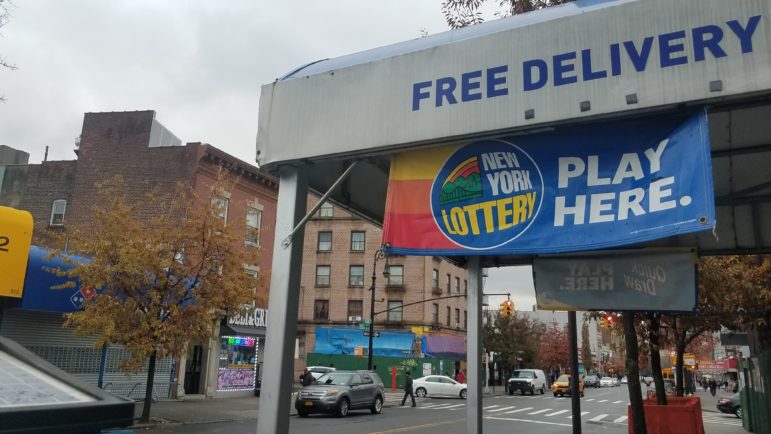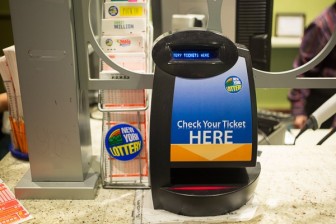
J. Murphy
Place your bets: 204th Street in the Bronx.
Today will be a busy day for New Yorkers who play the lottery.
The 3-digit game known as Numbers has a drawing at 12:20 and another at 7:30 – the same times that Win 4 does its twice-daily picks of digits. At 8:30 is the Pick 10 drawing, and then Cash for Life comes in at 9 p.m. After a short break, at 11 p.m. we’ll find out if anyone who placed a $2 bet can claim the $192 million Mega Millions jackpot. Twenty-one minutes later is the Take Five drawing.
For those who fall short Tuesday—as the vast majority of players will—fear not: On Wednesday a drawing for the $80 million Power Ball jackpot is on tap, as is the $4.8 million Lotto, along with the daily games: Numbers, Win 4, Take 5, Pick 10. Come Friday, you get another shot at Mega Millions. On Saturday, the dailies Lotto and PowerBall draw again. And every four minutes, through day and the dead of night, every day of the year, a Quick Draw winner is crowned. Should that not do it for you, there are six dozen scratch-off games to choose from.
Today will be a busy day for New Yorkers who play the lottery because every day is a busy day for New Yorkers who play the lottery. That’s how the system made $10.3 billion last fiscal year. About $3.5 billion of that revenue went to support education – the justification for changing the state constitution to create the lottery more than five decades ago.
Now Bronx Borough President Ruben Diaz, Jr., alarmed by the impact of the lottery on low-income communities, is calling for a new round of changes to shape where the lottery is conducted and how the school aid is distributed.
“We should be more equitable and more nuanced about what we do with this revenue, especially if low inc people are playing at higher rates than more affluent people,” Diaz tells City Limits. “We’re being shortchanged.”
Disproportionate impact
The beep, who is term-limited and a likely candidate for mayor in 2021, proposed in a report released Monday that the lottery’s education aid be directed only to high-poverty, Title I schools. And he’s calling for a ban on the sale of lottery products in check-cashing outlets, which serve unbanked, low-income people. Taken together, the proposals are attempt to mitigate the regressive nature of the lottery. According to the borough president’s report:
Nationally, lower income individuals are more likely to play the lottery than higher income individuals. Additionally, low-income individuals spend a disproportionate proportion of their incomes on the lottery. White individuals are more likely to play the lottery than individuals from any other racial group, but black individuals who purchase lottery games play more frequentlyand spend more overall. According to a survey by Bankrate, 28 percent of individuals earning under $30,000 per year play the lottery at least weekly as compared with 18 percent of those earning over $75,000. The average American spends $17 per week on lottery tickets. Additionally, a study about the lottery in Connecticut found that residents of poorer ZIP codes were more likely to play the lottery than resident of wealthier ZIP codes.
“Because low-income people purchase a disproportionate amount of the lottery games, this has the effect of pulling money away from low-income people and out of their communities,” the report continued. “And while the education funding that the lottery provides helps support districts across the state, low-income people’s disproportionate purchase of lottery games should necessitate that the revenue from lottery sales be directed more heavily towards schools in low-income communities.”
New formula needed?
Diaz contends that the current distribution formula, while taking income-levels into account, puts too much weight on other factors. Shifting to send the aid only to Title I schools will correct that imbalance, and not necessary to the exclusive benefit of the five boroughs. “There are a lot of upstate schools that are also eligible for Title I,” the beep notes.
Diaz argues that extra lottery money could be used by Title I schools for broader, school-based anti-poverty measures like financial literacy, test prep and career counseling so long as those initiatives meet the constitutional requirement of being “in aid or support of education.”
“Under that umbrella let’s get more nuanced. Let’s get counselors and be more expansive about our English-language learners program,” Diaz says. “Let’s do things like finance after-school programs in the communities that need them. Let’s have mental-health clinics in the schools. Let’s do internship programs. We need financing for that.”
The New York State Gaming Commission, which oversees the lottery and other gambling in the state, said in a statement that it was reviewing the report.
 Placing Our Bets: Gambling in New YorkOctober 2013
Placing Our Bets: Gambling in New YorkOctober 2013Six years ago, New York was on the verge of deciding whether to allow casino gambling. But the state has long been in the business of drawing revenue from games of chance. This series looked at the winners and losers from the state’s experiment with gaming.
Cash checks, play elsewhere
According to 2013 statistics, about 12 percent of New York City households do not have a traditional bank account, and another 25 percent are “underbanked,” meaning they do have a regular bank but still use alternative financial services like check-cashing stores. Those numbers are higher in the Bronx, where 22 percent have no bank and 31 percent are underbanked. As far back as 1994, when then-Public Advocate Mark Green called attention to it as a “dubious” policy, there’s been some level of concern about permitting lottery sales in check-cashing establishments.
Diaz wants to ban those sales—which he says are “pervasive”—to “discourage the low-income populations that typically use check cashing services from purchasing those games, according to the report.
“While the lottery does help to support education in New York, playing the lottery is generally a losing proposition,” it read. “Low-income people should not be encouraged to spend their money on the lottery at businesses that already cause them to spend more money than they would from using traditional banking services.”
The ban on check-cashing lottery sales would also help to combat problem gambling, Diaz says. He contends the state does very little research on the extent of gambling addiction and offers no gambling-treatment programs in the Bronx and 39 other of the states 62 counties.
Still a wise wager?
But if gambling addiction is a real concern, the lottery’s lure is so dangerous that it must be banned from some places and low-income people are disproportionately funding state education aid that might otherwise be generated by a progressive tax system, why not get rid of the lottery altogether?
Diaz, who says he plays the lottery when jackpots breach $100 million, believes a broader ban is simply not possible, or even appropriate. “That horse is already out of the barn,” he argues. “People have every right to play the lottery or gaming if that’s what they choose.”
Les Bernal, national director of Stop Predatory Gambling, isn’t so sure. He credits Diaz with starting a conversation that could leader to a broader reconsideration of the wisdom of funding schools through gambling.
“The billions of financial losses suffered by low-income citizens at the hands of the State Lottery is New York’s biggest most-neglected barrier to mobility out of poverty today,” Bernal tells City Limits. “How long the Lottery’s predatory practices continue will be the measuring stick for public officials, opinion leaders, and concerned citizens of all political stripes who profess a desire to improve opportunity and alleviate poverty yet lament how few levers they have to pull. This proposal is a much-needed first step.”








